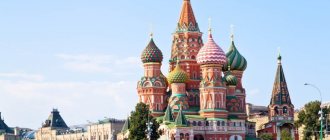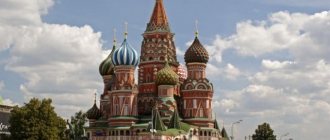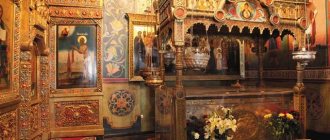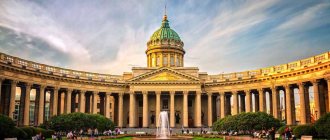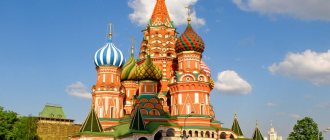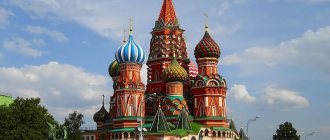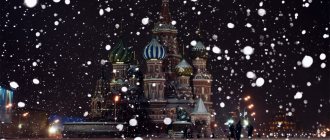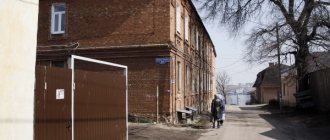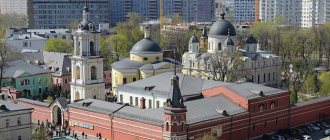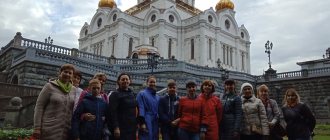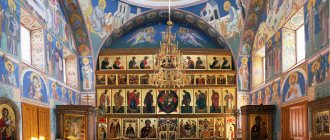Intercession Cathedral is a building monument in Moscow - the Orthodox Church of the Intercession of the Blessed Virgin Mary, which is on the Moat. Located approximately in the southern corner of the main square of the country, the exact location of the monastery is Red Square 7.
There is also another name that people often use - St. Basil's Cathedral. The monastery is included in the all-Russian list of UNESCO World Heritage Sites and is one of the branches of the State Historical and Architectural Museum.
Reasons for foundation and dating
During the Kazan campaigns, “camping” churches made of wood were installed on Trinity Square as a reminder of the conquests. 10/02/1552 Ivan the Terrible triumphed over the Khanate, as a result of which Kazan joined the Moscow state, and the prince ordered to unite all the churches together. The cathedral acquired the name Intercession, because 01.10 - Intercession of the Blessed Virgin Mary.
Construction of the monastery started in 1555 and was carried out only in the summer. Most of it was built by September 1559. The cathedral was consecrated on the Intercession of the Virgin Mary, but not all of its churches; the central one was not yet finished by that time. The construction was completely completed in the summer of 1961. On July 2, the central Church of the Intercession was consecrated.
Versions of the construction of the cathedral
The history of the construction of the Intercession Monastery is mysterious. She has 3 legends.
First legend
The construction of the temple was supervised by 2 people - Postnik and Barma. These names have been legendary since 1895, in an unprinted corpus of the 17th century. found the words of the chronicler that two craftsmen nicknamed Postnik and Barma were sent to Ivan the Terrible by God himself. Upon completion of the construction, the prince was so delighted with the monastery that he decided to blind the architects.
According to one legend, the Intercession Cathedral in Moscow was controlled by two people - Postnik and Barma.
So that in the future craftsmen will not build anything as beautiful as a monastery. But this story has not been confirmed; the name of Faster is also indicated by other chroniclers in subsequent chronicles, which means that the master had vision and could supervise other construction projects.
The first to speak about blinding was the Holstein ambassador Adam Alearius, who called the cathedral “Jerusalem.” Another version of this legend speaks not of blinding, but of the imprisonment of the architect for boasting while drunk that he would build a temple more beautiful than Pokrovsky.
Second legend
This legend says that the temple was built by one architect - Postnik Yakovlev. He was given this name because he diligently fasted for a long time. He was one of the most skilled Pskov craftsmen. After the completion of the cathedral, he went to Kazan to oversee the construction of the stone city. A version originated in the 1950s.
There is a story about collecting coins for the construction of a church: St. Basil lived in Moscow, begged and threw all the collected coins over his shoulder in one place and no one touched them. When he collected a sufficient number, he brought them to John IV for construction. The facts indicate the opposite; Vasily died in 1552, even before Ivan Vasilyevich’s decision to build a temple.
But he was buried in the area where the cathedral was built. If you believe the Solovetsky chronicler, on August 2, 1588, thanks to the remains of St. Basil the Blessed, healings occurred. And then, the 3rd son of Ivan the Terrible - Tsar Fedor - introduced a holiday in honor of Vasily, in the same year many miracles happened from his tomb, this is stated in the New Chronicle.
Fyodor Ivanovich ordered a stone temple to be erected over the burial place of the holy fool, so in the same year, instead of the St. Nicholas Church, a ninth church was added to the cathedral, which began to be named in his honor.
Third legend
According to the latest legend, the construction of the temple was supervised by an architect who came from Western Europe, presumably an Italian. Evidence of this is the special style, which combines patterns of Western European and Russian architecture. But this theory has no evidence of veracity.
There is an opinion among historians that supposedly at first the temple was supposed to be an analogue of the Blachernae Monastery with the Church of the Virgin Mary. By its existence and location, the temple was obliged to approve the state ideology “Moscow is the third Rome.”
The Intercession Cathedral in Moscow, according to other information, was the idea of Metropolitan Macarius. He planned to depict the holy city of Jerusalem in the heart of the capital. The cathedral includes several churches united by one foundation; it was under this design that the “promised city” - Heavenly Jerusalem - was then envisioned.
The meaning of the colors of the domes remains unclear. 2 centuries ago, Nikolai Chaev (writer) believed that the colors were associated with the dream of Andrei the Fool. He dreamed of the gardens of Jerusalem, with various trees blooming, either with yellow foliage or fruits.
Cathedral of the Intercession of the Blessed Virgin Mary
Since 2000, the patriarch of the described church has been based in this cathedral. The Intercession Cathedral is located in the capital at the address: Novokuznetskaya street, house 38.
Active construction of Old Believer churches began in Russia after 1905. It was then that a manifesto on religious tolerance came out. Moscow was no exception. The land plot on which this temple is located today was acquired by Fyodor Morozov in 1908. That same year, on October 12, the first stone was laid in the foundation of the church. The local Old Believer community began to look forward to the completion of construction.
The architect Desyatov worked on the building project. In total, this work required 100 thousand rubles. The grand opening of the temple took place in 1910. The first priest to conduct services was Mikhail Volkov, who had previously worked in the Polezhaevs’ home church, which was located on Luzhnetskaya Street. Over the next 20 years, prayer meetings of Old Believers were regularly organized here.
In the early 30s, Ferapont Lazarev, deacon of the Intercession Cathedral, was arrested. He was accused of counter-revolutionary activities that he carried out in the Old Believer group. On March 2, 1931, he was shot. Soon the Soviet authorities finally closed the church. The last service took place in May 1932.
After that, the building housed a department of OSOAVIAKHIM, the predecessor of the modern DOSAAF. In the 70s, Metrostroy began to be based.
Only after the collapse of the Soviet Union was the building returned to the Russian Old Orthodox Church. This happened in 1990. In 2000, the primate's chair moved from Novozybkov.
Changes in the 16th century
During the winter months, there were no services in the monastery, and it was not heated. Only in 1588, after the construction of the ninth temple - St. Basil's, such an opportunity arose. It became the only warm church. Services were also held at night, which is why the name of the ninth church acquired the meaning of the popular name of the monastery.
In the middle of the 16th century. the cathedral looked different. It was stylized as brickwork, and the painting was decorated with a fresco. The bell tower looked different, and there was no porch at all. Initially, the union of churches was mostly of a memorial nature: a tented church surrounded by 8 separate churches - symbols of the fateful battles for Kazan.
By the end of the 16th century, the cathedral's figured domes were installed; the original ones burned down in another fire. There is no specific date for this event.
The internal structure of the cathedral is small, has a small capacity and is united by a network of labyrinths. Because of this, during major church holidays, people met on Red Square, and not inside the cathedral. On such days it played the role of a kind of large altar in the fresh air.
The lectern - a high table with a flat top, used during worship, was placed in the location of the clergy - on the Execution Ground.
Improvements to the temple in the 17th century
In the 17th century The monastery has undergone global changes. In 1670, its unified whole was replenished with:
- tented belfry;
- the domes were covered with iron;
- open areas were covered with tiles;
- the appearance was updated with colorful painted patterns;
- dilapidated wooden churches on Red Square were closed.
In 1672, another chapel was formed; it was built over the burial place of the holy fool John.
The monastery underwent a global restoration in 1680-1683:
- the walkways were made of brick;
- the belfry was removed, a domed bell tower was installed and the roof deck was renewed;
- the altars of 13 or 14 (exactly unknown) churches located along the edge of the moat on Red Square were moved to the basement;
- the external and internal decoration was painted with herbal patterns.
Information about all the changes was displayed on ceramic tiles, which updated the appearance of the cathedral.
Fire and restoration in the 18th century
The Intercession Cathedral in Moscow was almost completely destroyed during the Trinity fire, which happened on the feast of the Holy Trinity on May 29, 1737. The reconstruction of the architecture and decoration of the temple was led by the architect Ivan Michurin. He drew up a plan for the cathedral with a description during the Renaissance period.
A new stage in the renovation of the temple and its architecture took place in 1784-1786. by order of Catherine II. Archbishop Platon received 10,000 rubles from her for restoration work, the leader of which was the architect Ivan Yakovlev.
During this period, the northern façade of St. Basil's Cathedral underwent changes: the Fedosievskaya Church, which had adorned the temple from the north for more than 100 years, was dismantled. From its lower tier they made a covered porch of St. Basil's Church, and the arrangement of the second tier became a new cathedral vestry.
In the 18th century The cathedral had not yet acquired its modern appearance: the walls were lined with two-story bookstores, and Apple Row was located nearby. But already under Alexander I, all arbitrary buildings were destroyed, the slope was leveled, the walls were covered with wild stone and covered with metal bars.
Nowadays
Today Rogozhskaya Sloboda lives its own, active and full-blooded life, where the Old Believers remain the main priority. Ancient hospitals, ancient temples, a necropolis, which once came into being thanks to the financial support of many merchant dynasties: the Ryabushinskys, Mamontovs, Morozovs, etc., have been revived. Thanks to the nature of their activities, the Old Believers were able not only to assert the right to faith, but to create a unique architectural ensemble, there are no others like it. The village seemed frozen in time - it still remains the spiritual center of the Moscow Old Believers, its stronghold, hidden from the eyes of the rest of the townspeople.
Changes from the 19th – early 20th centuries
In 1812, during the war with Napoleon, the French placed their horses in the basement of the temple.
There are 2 legends about the events of this period:
- Napoleon was so amazed by the beauty of the Intercession Cathedral that he wanted to transport it to France. But then he realized that this was not so easy to do, and in this case, he decided to simply blow it up. Muscovites prayed that this would not happen, and rain began to fall, which put out the wicks of Napoleonic cannons. This legend has no written confirmation.
- Napoleon ordered the temple to be burned, but the explosion never happened. But the temple utensils were stolen or desecrated. The roof of the temple was damaged by stone parts of undermined Kremlin buildings.
In Moscow, after the end of World War II, the main square began to be improved. Osip Bove, the master who was involved in the restoration of the food stalls, strengthened the supporting walls of the Intercession Cathedral with wild stone and erected a cast iron fence.
In 1880, an estate was built next to the temple on Pyatnitskaya Street. Until 1918, the abbot of the monastery, John Vostorgov, lived there, a popular church figure and preacher who had close contact with Grigory Rasputin. On September 5, 1918, he was executed for preaching speeches condemning the Bolsheviks. And in 2000, John Vostorgov was added to the list of saints of the Russian Orthodox Church.
During the last 10 years of the 1800s. The monastery again underwent global reconstruction. The flooring was made stronger, and the sacristy of the cathedral was decorated with multi-colored stained glass windows created by Andrei Pavlinov (architect of the Moscow Archaeological Society). In 1900-1912 The reconstruction of the monastery was led by master Sergei Solovyov.
Reminder for tourists
Photo: map of Rogozhskaya Sloboda
Divine services in Rogozhskaya Sloboda take place every day: morning services begin at 7:30, and evening services at 15:30. Before the holidays, evening services take place at 14:00. All temples are open to tourists. There are some requirements for clothing and behavior. Men are required to wear clothing that covers the entire body (trousers and a long-sleeved top). The same requirements apply for women: a skirt that covers the knees, outerwear with sleeves and a headscarf. Representatives of other faiths should not perform prayers or similar actions, and when they come to the temple, they must stand at the western entrance (at the vestibule).
You can get to the village using the Rimskaya, Taganskaya, Aviamotornaya and Marksistskaya metro stations. The shortest route from “Rimskaya” and “Aviamotornaya” will be on foot. Buses No. 15 and No. 169 depart from Marxistskaya; from Taganskaya - trolleybuses No. 16, 26 and 63. Just get off at the Staroobryadcheskaya Street stop and you can find yourself in Rogozhskaya Sloboda. It is worth taking a tour not only of the churches, but also of visiting church shops, Sunday schools for adults and children, and shops selling folk costumes. The restaurant serving the original cuisine of the Old Believers is also of tourist value.
Rogozhskaya Sloboda official website: rpsc.ru/rogozhskaya-sloboda/
Museum time of the cathedral, XIX – XX centuries
1918 - the process of transforming St. Basil's Cathedral into a museum display began. It was taken under the protection of the country as a monument of national and international significance. After the revolution, the monastery was in poor condition: the roof was leaking, the windows were broken, and in winter there was even snow inside the temple. In the 1920s started restoration activities.
And already on May 21, 1923, the historical and architectural museum began its work there, and the scientist of the State Historical Museum E.I. became its director. Silin. In 1923-1949. On the basis of the museum, a global study of the monastery was carried out. During which, underground tunnels connecting the temple with the Kremlin were discovered, and the purpose of several rooms located in the basement of the cathedral was revealed.
In 1929, services in the monastery were completely stopped, which is why the bells were sent for melting down. And in the 1930s. Lazar Kaganovich, who was involved in the reconstruction of Red Square, tried to get the temple demolished to increase the area for parades, but was refused by Joseph Stalin. In 1936, they tried to demolish the temple again, allegedly it interfered with vehicle traffic.
During the Great Patriotic War, the cathedral was also badly damaged. Immediately after the victory of the Red Army over the Nazi invaders, they began to restore it. And already on the day of the 800th anniversary of the city of Moscow, the museum opened again (09/07/1947).
In 1954-1955 For the first time, all the walls were restored and the layers of paint were examined: the appearance of the 16th century was returned to the cathedral. (the cathedral was again painted to look like brick, and the white stone parts of the decoration were reconstructed). Also for the first time during the entire period of the cathedral’s existence, in 1967-1969. the domes were covered with copper.
Church history
The basis of the Old Orthodox Church was originally made up of the Beglopopovtsy. This is part of the Old Believers who accepted the priesthood passing from the New Believers Church. However, they did not recognize the Belokrinitsa hierarchy.
In 1923, the majority of members of the Old Orthodox Church recognized Saratov Archbishop Nikola as their head. His contemporaries noted that the already elderly monk Nikola quite unexpectedly switched to the renovationists. Many even believed that he was out of his mind. He became disillusioned with the Renovationists after about a year, but did not return to the Russian Orthodox Church, but switched to the Old Believers.
In 1929, another famous clergyman, the Bishop of Irginsky, joined the Old Orthodox Church.
Cathedral today
The Intercession Cathedral in Moscow today is fully functioning as a gallery and temple. Services are held on Sundays and Easter. In 2001-2011, regular restoration work was carried out, their results were: updated decoration of churches, a restored image of the Intercession of the Blessed Virgin Mary, and the return of the basements to their original appearance.
In 2008, the monastery was included in the 7 “Wonders of the World” of the Russian Federation. And in 2021, it was named an exceptional architectural monument and added to the list of UNESCO World Heritage Sites.
Old Orthodox Pomeranian Church
The Old Believer Pomeranian community of the Old Orthodox Pomeranian Church plays a major role in Russia. Today it is the largest religious association of Old Believers of the Pomeranian consent.
This spiritual center was founded in 1694. Then a men's monastery was founded on the Vyg River. In 1706, a women's room appeared in Leksinsk.
They became famous for composing the famous Pomeranian answers, which became the actual basis for the defense of Ancient Orthodoxy. By the 19th century, Pomeranian communities had become a key economic center in the north of the country.
Architectural features of the cathedral
The initial appearance of the temple was classical, however, even at that moment it already had specific qualities - diversity of structure, lack of emphasis in the main facade, an exaggerated role of the exterior with rather small interior spaces. All these qualities in tandem captured the concepts of “temple-city”, “heavenly Jerusalem”.
The picturesqueness of the temple in the 17th century was enhanced by the asymmetrical extensions, domes over the porches, patterned paintings outside and inside the cathedral, and complex pictorial treatment of the domes.
A unique feature of the temple is the absence of a deep foundation at a 60-meter height. Its only foundation was a strip foundation, no more than 2 meters deep. Because of this information, doubts arise about the veracity of the story about the existence of Ivan the Terrible’s book depository in the basements.
The center of marvelous icon painting Rogozhskaya Sloboda
Photo: Rogozhskaya Sloboda. Old Believers
Almost every church in Rogozhskaya Sloboda is an icon painting museum. The shrines also contain church utensils, books and ancient manuscripts, icons of unprecedented beauty in gilded and silver vestments. But the main value of the icons lies in their originality and pristineness: these works belonged to the masters of Pskov and Novgorod writing, so there are no imprints of later stylistic influences on them.
The most famous and ancient icon is the “Savior the Terrible Eye”. The Old Believers in Rogozhskaya Sloboda also had the Bogolyubskaya and Smolensk icons of the Mother of God. By the way, the authorship of the latter is attributed to the famous Andrei Rublev, a revered master of icon painting of the Moscow school.
Located at the Rogozhskoe cemetery, the Intercession Cathedral has preserved to this day icons from the Soldenko and Rakhmanov collections, which are distinguished by their great value and antiquity. The cemetery archive and library could boast of unique early printed books and ancient manuscripts, which are now kept in the Rumyantsev Museum.
Temple structure
The Intercession Cathedral in Moscow consists of 10 churches. 8 end with onion domes and stand around the outstanding main tower church of the Intercession of the Blessed Virgin Mary. In general, the Intercession Monastery has 11 chapters: 9 above the churches, 2 above the belfry and the side chapel of St. Basil. The 9 churches have a common base, circular and closed aisles with a vaulted ceiling.
First floor
St. Basil's Cathedral does not contain basement rooms.
Churches and passages are located on a common basis - the basement.
Podklet
Its walls are 3 m wide and form rooms with a ceiling level of approximately 6.5 m. Previously, they were locked to visitors to the cathedral, and the recesses in the walls were used as secret storage rooms, which were closed with doors; in the present period, only hinges have survived from them. Until 1595, the tsar's money and property of wealthy city residents were hidden in the basement's hiding places.
Previously, the entrance to the basement was on the internal staircase from the main church. Later it was laid down, but during the renovation of the 1930s. revealed secret steps. Nowadays, in the underground there are images of St. Basil the Blessed from the 16th century. and 2 images of the 17th century. : “Our Lady of the Sign” and “Protection of the Blessed Virgin Mary”.
Church of St. Basil the Blessed
It was added to the monastery in 1588 over the buried Saint Basil. The shape resembles a cube and has a ceiling structure - a cross-shaped vault. It is crowned with a dome with a tubular base and a dome, made in the same manner as the domes of the higher churches of the monastery.
Church drawings in oil paints were made in 1905: Savior Pantocrator (dome), forefathers (drum), Deesis (in the crosshairs of the ceiling), Evangelists (in the transitions of the ceiling to the dome).
From the south on its wall there is an exceptional large image of “Our Lady of Vladimir with selected saints of the capital’s circle “Today the most glorious city of Moscow flaunts brightly,” made on metal. The iconostasis was created in 1895 according to the plan of master A.M. Pavlinova. The flooring of the church is laid with slabs of Kasli cast iron.
Second floor
The top floor of the monastery is formed of 10 churches surrounded by a gallery. Their modern appearance has been formed over the past 250 years.
Galleries and porches
An external corridor was laid along the monastery, which was initially open. Arches from it lead to platforms between churches and to internal passages, one of which rings the Church of the Intercession of the Blessed Virgin Mary, it is not visible because of the tops of the churches. In the current period it has tempera painting, and earlier it was painted with a floral pattern.
Afterwards, an oil painting with a plot appeared, it still exists. The flooring of the passage is made of bricks, some of which have survived from the 16th century. The entrance from the south remains in its original form, which makes it possible to imagine the decoration of the church at that time. The western area has a flat brick ceiling, preserved from the 16th century. The walls are painted to resemble brickwork.
Church of Alexander Svirsky
1 of the small churches, 15 m level, is located in the southeast. The original appearance of the device was returned during restoration work in the 20th century. The floor is laid with a herringbone brick pattern, the window sills have steps, the wall painting imitates brick, and in the dome there is an image of a spiral - an infinity sign.
The iconostasis has been transformed: at the top there are icons of the 16th-17th centuries. And the bottom is covered with velvet shrouds with a pattern of the Calvary cross.
Church of Varlaam Khutynsky
2 of the small churches, height 15.2 meters, located in the southwest. Asymmetrical in shape due to the passage between the small and central churches. The central chandelier with many candles has been preserved from the 15th century, created by Nuremberg masters, the oldest object in the entire cathedral. After 100 years, it was supplemented with a top in the form of a double-headed eagle.
The iconostasis consists of images from the 16th – 18th centuries. The most significant of them, “The Vision of Sexton Tarasius,” was created in Novgorod around the 16th century.
Church of the Entry of the Lord into Jerusalem
1 of the large churches, located in the west. It retained the original appearance of the details of the 16th century: the damaged areas were not restored, and the place where a shell fell during the fighting in 1917 remained.
The decoration of the iconostasis consists of gilded tin plates; in the 19th century. added patterned elements made of wood. The lower part of it tells about the Creation of the world. Among all the images, one of the significant images of the Intercession Cathedral is exhibited - “St. Alexander Nevsky in the Life of the 17th century.
Church of Gregory of Armenia
3 of the small churches, with a level of 15 m, is located in the northwest. It is also asymmetrical, due to the passage into the main church. The decoration of the church has been completely restored and corresponds to the 16th century. The iconostasis includes icons from the 16th – 17th centuries, attached between wooden beams – chapels. At the bottom it is covered with shrouds of velvet and silk with drawings of Calvary crosses.
Church of Cyprian and Justina
2 of the large churches, with a level of 20.9 m, is located in the north. The Blessed Virgin “Burning Bush” is depicted in its dome.
The iconostasis is gilded, carved from wood in a classic manner in the 18th century. Below are pictures of the Creation of the world (days 1 and 4). The church walls are painted in oils: Cyprian and Justina are depicted on top, Adrian and Natalia below. They are complemented by installations of Gospel parables and scenes from the Old Testament.
In the 1780s. the church was renamed in honor of Adrian and Natalia, and this is why their appearance in the descriptions is associated. But in 1920, when the museum was just starting its work, it was renamed back.
Church of St. Nicholas Velikoretsky
3 of the large churches, with a level of 28 m, is located in the south. In 1737, a fire caused great damage to it.
The patterned iconostasis was created in the 18th – 19th centuries. The images are painted in oil, located in narrow frames, the iconostasis itself is decorated with sculpted flowers and gilding. The surface of the walls is painted: words from the Nikon Chronicle about the bringing of the image of St. Nicholas the Wonderworker to the capital (below), the Blessed Virgin on the throne among the seers (above), the apostles (above), the Savior Almighty (ceiling).
Holy Trinity Church
4 of the large churches, with a level of 21 m, is located in the east. Based on the results of restoration activities in the 1920s. it received a more accurate representation of the decorative and construction interior of a long time ago: pilasters and half-columns as a frame for arches - entrances, a spiral of brick was laid on the ceiling.
The iconostasis is extraordinary - another model of the low royal doors, and three-row icons (forming 3 canonical ranks - solemn, divinatory and Deesis). In this church there is an image of the “Old Testament Trinity”, one of the oldest images of the monastery (XVI century).
Church of the Three Patriarchs
4 of the small churches, with a level of 14.9 m, are located in the northeast. There was a period when it was renamed in honor of Gregory of Armenia, but in the 1920s. The church regained its first name.
On the ceiling of the church is the installation “Savior Not Made by Hands.” The iconostasis is formed of 5 rows and contains baroque and classic elements. The walls are painted with oil in the 19th century, the bottom is dedicated to Gregory of Armenia, the top is the origin of the image of the Savior Not Made by Hands.
Central Church of the Intercession of the Virgin Mary
The largest church, with a level of 47.5 m. The iconostasis is decorated with tin overlays and gilding; it was previously located in the Church of the Chernigov Wonderworkers in the Kremlin (it was dismantled in 1770)
Bell tower
The base of the bell tower is a large square, on which there is an 8-corner open platform, fenced with pillars with arches. The top is covered by a tent, decorated with multi-colored ceramic tiles coated with glass, and ends with an onion-shaped dome with an eight-pointed cross.
There are small windows in the roof of the tent to enhance sound. Inside hang bells cast in the 17th - 19th centuries.
Temple opening hours
The Intercession Monastery is open daily from 11:00 to 17:00. The ticket office closes for 45 minutes. before the end of the working day. During the summer, the temple is open daily from 9:00 to 21:00. During school holidays, the cathedral's working day increases by 60 minutes. If it is -15 outside, changes in the work schedule are possible. Contact number.
Cost of visits
Table:
| Category | Price |
| Young people 16-18 years old and students of higher educational institutions of the Russian Federation | 150 rub. |
| Retired people | 150 rub. |
| Adults | 500 rub. |
| Foreign guests | 700 rub. |
| Preferential groups of residents | 150 rub. |
| Family ticket (two adults and children under 16 years old) | 600 rub. |
Ticket - complex:
| 800 rub. 1200 rub. |
On the last Sunday of each month, the following people can visit the main exhibition for free: large families, students of the Russian Federation and schoolchildren aged 16-18 years old if they have a document from their place of study.
Visiting rules
Mandatory rules that all museum visitors must follow.
Otherwise, the administration has the right to ask violators to leave the temple:
- It is prohibited to touch display cases, exhibits and elements of the interior of the cathedral.
- It is prohibited to leave small children unattended.
- Hand luggage larger than 30x40 cm must be checked into the cloakroom.
- Free photography and video shooting is allowed without the use of flash or tripods.
- Photo and video filming is prohibited at any temporary exhibitions taking place on the territory of the Intercession Cathedral.
- Due to the small size of the temple premises, visitors in wheelchairs or with a baby stroller cannot get inside.
Community today
The modern history of the community dates back to 1989. Then the Russian Council of the Ancient Orthodox Church was created.
In 2006, the All-Russian Council took place, the first since 1912. According to official data, there are now 50 religious organizations related to the Old Orthodox Church registered in Russia. There are about two hundred other similar groups and communities without registration. At least 250 more communities operate outside the country.
There are public organizations working under the Old Orthodox Church. Magazines and other periodicals are published, and children's and youth summer camps are held. There are even theological schools in St. Petersburg and Riga, where seminarians are trained annually.
Programs for visitors
Today, the temple-museum has created a number of various excursions, thanks to which even foreign guests can get acquainted with the history of the cathedral.
Special excursions
Special excursions that allow you to see the temple in a different light:
- "The Intercession Cathedral - a temple - a museum on Red Square." An excursion for foreign guests, allowing you to visit the temple an hour before the start of the monastery’s work or within an hour after the end of the working day, accompanied by a guide-translator. Prior approval from the museum is required. Group – up to 20 people, duration – 1.5 hours. Price: for citizens of the Russian Federation and CIS countries – 2000 rubles. per person, for foreign citizens – 4000 rubles. per person.
- "Evening Intercession Cathedral". The tour allows you to see the beauty of the monastery in the evening. Held only in summer, starts at 18:30. Age limit – 14+. Group – up to 30 people, duration – 1.5 hours. Price: 2000 rub. per person.
Sightseeing tours
During the sightseeing tour, visitors can learn the general history of the temple, what it looked like in ancient times, how it has changed over 450 years, and the history of each church separately. There are 6 options for excursions, the group size for each of them is a maximum of 15 people, duration is 1.5 hours. The price of 5 excursions is 3500 rubles, 6 excursions for foreigners are 6000-7000 rubles. (depends on the language).
Scroll:
- Intercession Cathedral is an architectural and historical monument of the 16th century. (16+).
- Symbol of Russia : Intercession Cathedral in Russian history and culture (schoolchildren, 9-11 grades).
- Living antiquity within the walls of the Intercession Cathedral: if I were an ancient warrior, builder, painter... (schoolchildren, 1-4 grades).
- A wondrous wonder : secrets of the ancient walls of the Intercession Cathedral (schoolchildren, 6-8 grades).
- Intercession Cathedral is a pearl of medieval architecture (for foreigners).
- One day on Red Square (includes a tour of the Intercession Cathedral).
Thematic excursions
By visiting some of them you can learn the history of the monastery during the war period, how the architecture and painting of the temple was created, the history of the icons located in the monastery. Excursions are also designed for groups of high school students. General criteria for each excursion: group - up to 15 people, duration - 1.5 hours, cost - 3500 rubles.
The Intercession Cathedral is one of the oldest architectural monuments of Russia, located in Moscow. One of the most famous symbols of the Russian people. It is necessary to visit it for the sake of cultural development and replenishment of knowledge about the history of the Motherland.
Author: Gaechka
Article design: Oleg Lozinsky
